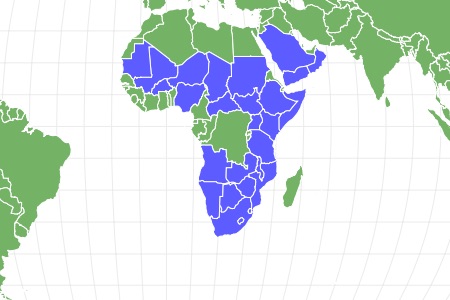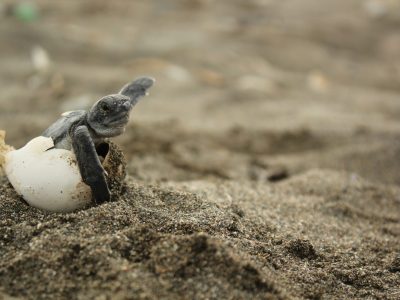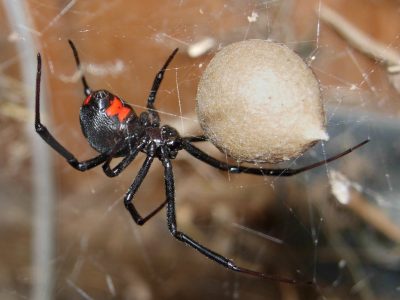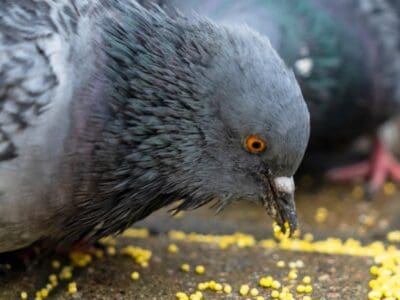Lappet-faced Vulture
Torgos tracheliotos
Lappet-faced vultures are tidy and wash their heads in a body of water after they’ve eaten
Advertisement
Lappet-faced Vulture Scientific Classification
- Kingdom
- Animalia
- Phylum
- Chordata
- Class
- Aves
- Order
- Accipitriformes
- Family
- Accipitridae
- Genus
- Torgos
- Scientific Name
- Torgos tracheliotos
Read our Complete Guide to Classification of Animals.
Lappet-faced Vulture Conservation Status
Lappet-faced Vulture Facts
- Prey
- Smaller birds, mammals, insects and reptiles
- Fun Fact
- Lappet-faced vultures are tidy and wash their heads in a body of water after they’ve eaten
- Biggest Threat
- Poisoning by humans, loss of prey due to habitat disruption
- Most Distinctive Feature
- The “lappets” on its head that give the bird its name
- Other Name(s)
- Nubian vulture, African eared vulture
- Wingspan
- 8.2 to 9.5 feet
- Incubation Period
- Seven to eight weeks
- Litter Size
- 1
- Habitat
- Deserts, dry savannas, dry scrub, mountain slopes, wadis
- Predators
- Humans
- Diet
- Carnivore
- Type
- Bird
- Common Name
- Lappet-Faced Vulture
- Number Of Species
- 1
- Location
- Africa and the Middle East
- Average Clutch Size
- 1
- Nesting Location
- At the top of a tree
- Age of Molting
- 125 to 135 days
- Migratory
- 1
View all of the Lappet-faced Vulture images!
“The Lappet-faced Vulture is Africa’s largest vulture”
Also called the Nubian vulture, this great bird of prey probably makes the lives of other vultures possible. That’s because it is often the only vulture strong enough to open up the carcass of a large animal with a tough hide. Though it has a reputation as a bit of a bully, it may hang back while others have their fill. This leaves the lappet-faced vulture with the choice bits. Those would be tough tendons, bones, and what’s left of the hide.
Four Amazing Lappet-Faced Vulture Facts
- It communicates through growling, yelping, hissing and grunting, especially at a feeding site.
- When the vulture reaches a carcass its very size allows it to dominate the other scavengers, even though it spends most of its time threatening them instead of eating.
- The “lappets” that give the vulture its name keep food out of its ears while it feeds.
- The bird’s stomach acid is so powerful that it can dissolve bones and kill pathogens that would make other animals sick.
Where To Find the Lappet-Faced Vulture
This enormous vulture can be found in dry and semi-dry habitats with not much ground cover in much of Africa. The nominate species is found mostly in eastern and southern Africa, including Makgadikgadi Pans and Kruger National Park, and the Blouberg Nature Reserve. Torgos tracheliotos nubicus is found in the Arabian Peninsula and south to Egypt and Sudan, while T.t. negevensis is now only found in captivity.
Lappet-Faced Vulture Nests
Lappet-faced vultures build their nests at the tops of thorn trees a good distance away from other vultures. The nest can be 10 feet in diameter and both parents help to build it. It is made out of sticks and lined with grass and fur. The nest isn’t used until it is time to lay the egg, even if it’s completed. Until then, the parents sleep and rest near it. The pair may use the nest again and again.
Lappet-Faced Vulture Scientific Name
The vulture’s scientific name is Torgos tracheliotos. Torgos is Greek for “vulture,” trakhelia is Greek for “cartilage” and otus is Greek for “ear.” So the name translates into “a cartilage-eared vulture.” There are three subspecies: They are:
- Torgos tracheliotos tracheliotos
- Torgos tracheliotos nubicus
- Torgos tracheliotos negevensis
Lappet-Faced Vulture Appearance
Like most other vultures, the Nubian vulture’s head and neck are bald. It also has folds of skin that hang down over its ears and reminded someone of the lappets that hung from a lady’s lace cap. The lappets and the head and neck are pink to reddish. This makes the bird ugly, but the lappets and the bare head and neck are there for a reason. To scavenge, the bird has to stick its head all the way into a carcass, and putrefying entrails inevitably befoul it. Because there are no feathers to clean, the vulture just needs to swish its head and neck in a body of water to clean them off. Lappets also keep the ears clear.
The rest of the bird is huge in size, and individuals can grow to 45 inches long, have a 9.5 foot wingspan and weigh as much as 30 pounds. As with a lot of accipitrids females are bigger than males.
The bird has a black or dark brown back, white feathers on the thighs and a white or buff-brown belly partially covered by long black feathers that hang from the neck. The eyes are small and beady, but the bird’s eyesight is keen, and as it soars it can spot a carcass over a mile away. The bill is huge, hooked and notoriously powerful. The talons are not as strong as those of other birds of prey and aren’t good for grasping and carrying heavy objects.
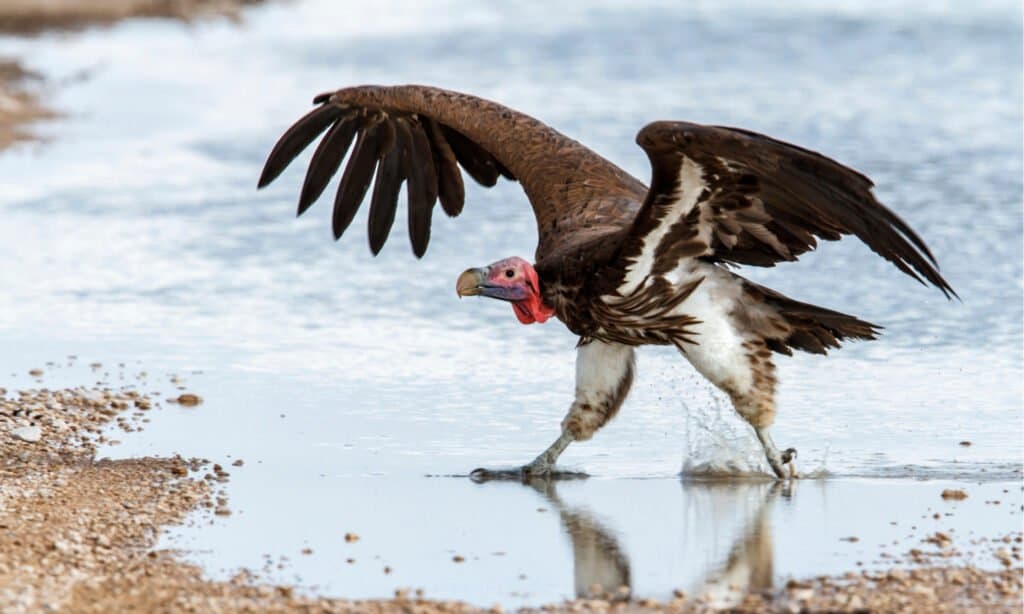
©Henk Bogaard/Shutterstock.com
Lappet-Faced Vulture Behavior
These vultures are solitary and are usually only found in groups near a water source or at a carcass, where they are known as a “wake.” They are aggressive at food sites and will threaten other vultures and even jackals even when those animals appear to submit. On the other hand, the lappet-faced vulture sometimes waits until other animals are finished with the carcass so they can eat whatever is left over, including skin, bones and tendons.
Lappet-Faced Vulture Migration Pattern and Timing
Most populations of lappet-faced vulture don’t migrate save those in the western part of its range. These birds tend to fly north during the rainy season between April and July then return during the dry season, between August and March.
Lappet-Faced Vulture Diet
Like other vultures, the lappet-faced is a scavenger. It prefers large game such as elephants, whose hide its strong bill tears through with little problem. It also seems to prefer the parts of the carcass that other animals won’t eat. The bird also kills and eats smaller animals. This includes other birds such as flamingos, and it will even eat insects, small mammals such as hares and reptiles. It also steals freshly killed food from other birds of prey. The crop of a well-fed lappet-faced vulture can hold as much as 3.3 pounds of meat.
Lappet-Faced Vulture Predators and Threats
The vulture’s greatest threat comes from human beings. This is because humans poison the carcasses the vulture eats, though this poison is often meant for jackals. Poachers also poison the carcasses of elephants they kill for ivory, for flocks of scavengers let rangers know the poachers have been in the area. Habitat destruction makes prey harder to find and nests harder to build. Other than this, the size and aggression of a grown lappet-faced vulture make sure that the bird is not bothered by natural predators.
Lappet-Faced Vulture Reproduction, Babies, and Lifespan
These birds are monogamous and mate for life. They have one breeding season per year, but the timing depends on where the bird lives. Birds in east Africa can breed all year long, but birds in the south breed from mid-spring to mid-summer, and birds in the north probably breed from November till late summer. They build their nest well away from the nests of other vultures, and the female lays one egg that both parents incubate. The egg hatches after around seven to eight weeks, and the chick emerges covered in white down, though its naked head and neck are gray. It is fed regurgitated food by its parents. Though it’s about ready to fly after about four and a half months, the chick’s parents take care of it for considerably longer.
Lappet-faced vultures don’t start to reproduce until they’re about six, and their lifespan can be up to 50 years.
Lappet-Faced Vulture Population
According to the IUCN Red List, the lappet-faced vulture’s conservation status is endangered, and its population is decreasing. The population is estimated to be between 6500 and 8500 individuals. There are even fewer members of Torgos tracheliotos nubicus. Torgos tracheliotos negevensis, once found in the Negev desert, is basically extinct in the wild. It is found in zoos in the Arabian peninsula and in Israel.
View all 98 animals that start with LLappet-faced Vulture FAQs (Frequently Asked Questions)
Does the Lappet-Faced Vulture migrate?
Generally, the vulture doesn’t migrate, though vultures that live in the west go north during the rainy season and return to the southern part of their range in the dry season.
How many eggs does the Lappet-Faced Vulture lay?
The lappet-faced vulture lays one egg. It’s a buff-brown color with brown speckles.
How fast does the Lappet-Faced Vulture fly?
It can fly 30 miles an hour, and it usually soars to save energy.
What is the Lappet-Faced Vulture’s wingspan?
The wingspan of this big vulture can be over 9.5 feet.
When do the Lappet-Faced Vulture leave the nest?
They leave the nest when they’re between 125 and 135 days old.
Why is it called a lappet-faced vulture?
It gets its name because of the folds of skin that hang over its ears, which resemble lappets on caps.
What do Lappet-faced vultures eat?
Lappet-faced vultures are carnivores and scavengers and eat a wide variety of animal protein, from insects to reptiles, to smaller birds to garbage and of course, carrion.
Is the lappet-faced vulture endangered?
The IUCN Red list does list this fascinating vulture as endangered.
Where are Lappet-faced vultures found?
Nubian vulture is found in many of the drier habitats around Africa and in the Middle East.
Thank you for reading! Have some feedback for us? Contact the AZ Animals editorial team.
Sources
- IUCN Redlist, Available here: https://www.iucnredlist.org/search?query=Torgos%20tracheliotos&searchType=species
- Mpala Live, Available here: https://www.mpalalive.org/field_guide/lappetfaced_vulture
- Cincinnati Zoo, Available here: https://cincinnatizoo.org/animals/lappet-faced-vulture/
- AfricaFreak, Available here: https://africafreak.com/lappet-faced-vulture
- Monaco Nature Encyclopoedia, Available here: https://www.monaconatureencyclopedia.com/torgos-tracheliotus/?lang=en
- Seaworld Parks & Entertainment, Available here: https://seaworld.org/animals/facts/birds/lappet-faced-vulture/

